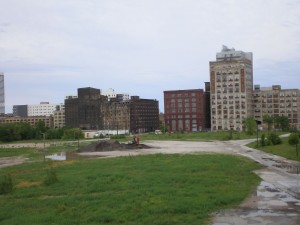School of Freshwater Sciences to the Reed Street Yards?

Reed Street Yards
It was recently reported that UWM is considering the Reed Street Yards as a potential site for the School of Freshwater Sciences. Although. I still think the lakefront site offers the most prominent location which would have played well with the re-branding of Milwaukee but, the Reed Street Yards site does have many positives that make it a suitable location. Simply put, if UWM were to build on the Reed Street Yards it could play a significant role in the revitalization of a neighborhood.
Another site under consideration is the existing Great Lakes Water Institute on E. Greenfield Ave., but this site is actually the worst of both goals, branding and revitalization. The area does need revitalization, but there just isn’t much of a neighborhood to revitalize as the site is fairly isolated. Further, the existing Great Lakes Institute is in reality a former tile factory, not a first-class research facility.
As I said in a previous article “The re-development of the Reed Street Yards is the next piece of the puzzle to the revitalization of Walker’s Point,” and building the School of Freshwater Sciences here, not only makes sense, but could be what gets this effort rolling.




















Excellent. That’s a great site. Really hope whatever goes there is integrated well with the rest of the are – ie, not a big parking lot.
UWM is considering the Reed Street Yards because they have lost touch with their core values.
All of your reasons for why it is a “good fit ” carefully avoid the core issues-Is it good for the science?Is it good in attracting students who want that science? Is it good in getting financial support from donors who are smart enough to understand that the future of water is based on science? See? Locating the school has to be about the SCIENCE. What else do you think will cause a student to value that SFWS graduate degree? If the GLRI and the SFWS remain science-driven, they will stay ahead of the pack, and that degree will be the the “gold standard” for water-related enterprise. The best students will come here to get it, the best professors will be hungry to teach and research here. Excitement, enthusiasm, and optimism will swirl around that degree. The students who try to get it will be filled with the certainty that they can make a difference in a global problem. With the right environment, the GLRI/SFWS campus could have the urgency of a Manhattan Project mixed with the positivism of the 60’s Peace Corp. The GLRI sits on 8 acres, allowing room to grow for its scientific and technical needs. Eight more acres are adjacent -and shovel-ready- on 1st and Greenfield, for the SFWS immediate,and future, academic needs. And the land UNDER the coal piles is 14 acres, offering the chance for on- campus incubators. UWM has put together 30 acres ON THE HARBOR, an amazing feat, providing it with unlimited room to expand, so it can capitalize on their inevitable success.
To move to the Reed Street Yards is an admission you do not believe in that inevitable success.
To move to the RSY is to say: ” We decided to limit our opportunities. We’re going to tell donors that this location is superficially prettier, therefore, even though it’s nowhere near the lake ,they should give us money. We’re going to assume those donors are stupid, and can’t see that we have permanently crippled our research,and our future, by downsizing. We’re going to tell prospective students that being in an airless, claustrophobic setting , staring at a coal barge canal IS the big adventure we have to offer them, and see if they buy that one. We’re going to tell the GLRI that the new $20 million dollar research vessel is best used less often, due to the coal barge’s twice a day runs, and ,getting through the four bridges. We’re going to say ,loud and clear, that we were afraid of putting our UWM mark on 1st and Greenfield, because that “stand-alone” image is less useful than speculating on an obscure location in a “Park East corridor in the making.”
UWM should demand greatness from its GLRI/SFWS professors and researchers, tell the prospective students that they’ll be pushed to the breaking point, buy every inch of harbor they can, and then put up the biggest sign possible on First and Greenfield that says: “Here is our core vision. It’s based on the Science of Water. Join us if you’re good enough.”
I stopped reading your comment after about 2 sentences, but thanks for the input.
CM Gross, you make some excellent points. I had been decidedly in favor of the Reed Street Yards site but your post is so persuasive that I’m reconsidering. I had not thought about the fact that the research vessel would have to go through four bridge crossings down condo canyon in order to get out to the harbor. John Gurda’s piece in this Sunday’s Milwaukee Journal Sentinel also raised the fact that the old tile factory that houses the WATER institute is perfectly suited to this kind of research, being an industrial building that can withstand heavy loads.
Most of the world’s most important scientific breakthroughs happened not in trophy buildings but in inconspicuous, ordinary buildings in out of way places. Top scientists and donors going to be impressed with the science first, the pleasantness of the surrounding a distant second.
Let’s keep the WATER institute where it is.
I’m just grateful this is one project that cannot and will not be built in the suburbs.
@Ben Actually it could. I believe UWM looked at some sites to the south, but at this point seems committed to a city site.